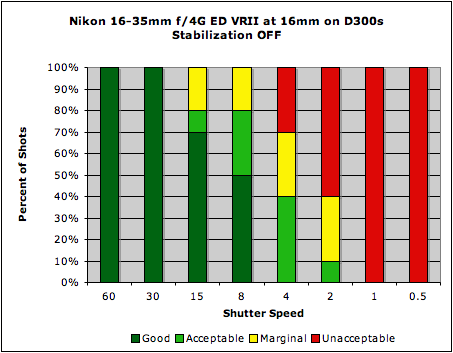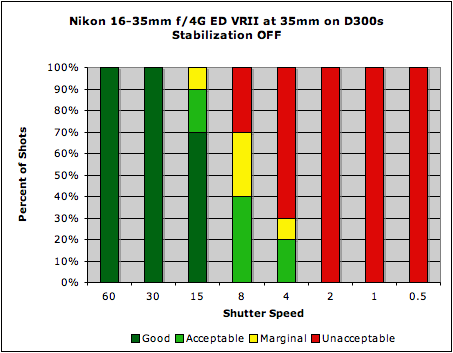Most people tend to think of image stabilization as being mainly for telephoto lenses. While it's true that their longer focal lengths tend to magnify the effects of camera shake, image stabilization can provde a very useful assist at wider angle focal lengths as well; anyone who's ever tried to blur the image of a waterfall, while keeping the surrounding landsape tack-sharp knows exactly what I'm talking about.
At the widest end of its range, the Nikon 16-36mm f/4G VRII produced somewhere between 1.5 and 2 stops of shake reduction in our tests: useful but unremarkable. The increase in blur with increasing exposure time was fairly gradual, though, so even at exposure times of a half a second, roughly half of the test images fell within either "Good" or "Acceptable" blur limits.
 |
| Mouse over this chart to show results with IS activated. |
At 35mm, the story was quite a bit better, with the lens conservatively providing a full 3 stops of blur reduction. At really slow shutter speeds, the lens' stabilization degrades fairly abruptly, as its moving element simple runs out of travel for compensating for camera movement. At 1 second, the 8 out of 10 shots captured were either Good or Acceptable, while at 2 seconds, none were. Overall, by allowing sharp, hand-held images at shutter speeds as slow as 1/2 to 1 second, the Nikon 16-35mm f/4G ED VR II makes a lot of otherwise impossible hand-held wide angle shots quite feasible.
 |
| Mouse over this chart to show results with IS activated. |
IS systems tend to provide more benefit to less-stable shooters than very steady ones, so most users will see the same or greater amounts of shake reduction as we measured here. You can read more about our IS test methodology here: SLRgear IS Test Methodology, v2.